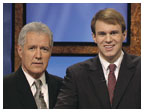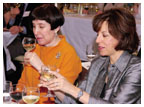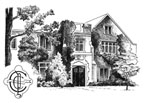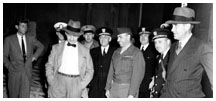
|
|
September 14, 2005: Notebook
Answer: Who is David Madden
°03?
Clue: This young alumnus is TV°s latest quiz show celebrity
Rice to speak as Woodrow Wilson
School turns 75
Anniversary events from Princeton to Tokyo
More graduates opt for the workforce
Campus Club shut; donation to University discussed
Working with small-town scholars
Policy on faith groups reversed
David Madden ’03, right, with Jeopardy! host Alex Trebek. (Jeopardy! Productions Inc.) |
Answer:
Who is David Madden ’03?
Clue: This young alumnus is TV’s latest quiz show celebrity
During the summer of 2004, David Madden ’03 phoned home from Berlin with an unusual request. He asked his parents if they could put the phone next to the television so he could listen to Jeopardy! Madden, who is studying international relations at the Free University of Berlin, explained that the long-running TV quiz show was not available on the German networks.
“At first they thought it was kind of odd,” said Madden, a Woodrow Wilson School major from Ridgewood, N.J. “But they know me and they know that I do all sorts of eccentric things, so over time it became normal.”
In the months that followed, Madden continued to call and listen to the show at 1 a.m. German time. He never mentioned to his parents that he appeared on 14 shows recorded in December 2004 and March 2005, winning $333,301 in prize money and the chance for more when the show begins airing new episodes in mid-September. The Maddens had their suspicions, but like the rest of America, they had to wait until July to watch their son write his name in the Jeopardy! record books with the second-longest winning streak in history.
To Adam Nebesar ’03, a Princeton friend and former roommate, Madden’s preparation for Jeopardy! and his success on the show made perfect sense. “He’s a great guy, but a little bit off the wall,” Nebesar said. “He’s also incredibly smart.” Madden’s hobbies range from bird-watching to Scrabble to fantasy baseball, and he’s passionate about all of them.
On a free day during a bird-watching trip to California in May 2004, Madden and friend Jeff Hoppes ’02 auditioned for Jeopardy! Both made the cut, but Hoppes, a graduate student at the University of California, Berkeley, drew the misfortune of competing against $2.5-million juggernaut Ken Jennings (Hoppes finished second). Soon after Hoppes’ show aired in November 2004, Madden was invited to Los Angeles for a December taping. “At that point,” he said, “I put all of the other things in my life on hold and went into cramming overdrive.”
Madden read trivia books to brush up on topics he thought would be his weaknesses, including movies and popular culture. He also devised a strategy of choosing questions from the fourth row of the game board first to increase his chances of hitting Daily Doubles and prevent competitors from vaulting past him in the standings. The plan worked — he uncovered 32 of the 42 Daily Doubles in his first 14 shows and clinched nine games before reaching the Final Jeopardy round.
While Madden is the most successful Princeton alumnus to compete on Jeopardy!, he is not the first. Past champions include Ed Schiffer ’80, a five-time winner in 1993; Matthew Morris ’98, the 1994 Teen Tournament champion; Jeffrey Stewart *99, who won the College Tournament as an undergraduate at Brigham Young; and John Cuthbertson *91, a five-time champion in 1994 who also reached the semifinals in this year’s Ultimate Tournament of Champions.
Jeopardy! celebrity reached new heights during Jennings’ streak in 2004, but whatever fame Madden has gained is barely noticeable in Germany. He is due to finish his master’s degree in the coming year, and though he plans to return to the United States eventually, he also wants to try living in India, China, and Latin America. “I’ve got some wanderlust in me that I have to sort out,” he said.
Aside from travel, Madden plans to save or invest most of his winnings. He has started a business called Meet and Eat–Berlin, which pairs travelers with local families for home-cooked German meals and conversations with Berliners, and he is donating $50,000 to set up scholarships in honor of two of his high school teachers. The thought of buying a Porsche to drive on the autobahns has also crossed his mind.
His experience on the show has been “a dream come true,”
says Madden, a Jeopardy! fan since his teen years. “In
one sense, I’ve been completely lucky,” he said. “But
I like to think that, as someone once said, ‘Luck is the residue
of design.’” ![]()
By B.T.
Category: Old Nassau
Sometimes knowing the answer is easier than saying it, as when a Jeopardy! “Rhyme Time” clue on July 7 asked David Madden ’03 and his fellow contestants to “Salute that grand old university in New Haven.”
“I was forced to say, ‘What is hail Yale?’ which obviously made me cringe inside,” said Madden, who banked $800 with the correct response. His knowledge of Princeton also helped the 14-day champion with these six alumni-related clues, each of which Madden answered correctly:
July 7
Read the Book
$400
The Beautiful and Damned, his second novel, takes place during the Jazz Age.
July 8
Death of a President
$1,000
He died in his sleep on Feb. 3, 1924, six months after Warren Harding.
July 11
Presidential Campaign Slogan Years
$600
“We’re madly for Adlai.”
July 13
In the Bookstore
$400
Billy Beane, this team’s wizard of a general manager, is profiled in Michael Lewis (’82)’s Moneyball.
July 14
Political Caricatures
$1,000
He was elected U.S. senator from New Jersey in 1978, 1984, and 1990.
July 22
Celebrity Lives
$800
In a 2003 bestseller, A. Scott Berg (’71) “remembered” this legendary actress who passed away at age 96.
Answers:
Who is F. Scott Fitzgerald ’17? Who is Woodrow Wilson 1879?
What is 1952 (or 1956)? Who are the Oakland Athletics? Who is Bill Bradley
’65? Who is Katharine Hepburn?

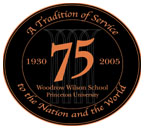 Rice
to speak as Woodrow Wilson School turns 75
Rice
to speak as Woodrow Wilson School turns 75
Anniversary events from Princeton to Tokyo
Secretary of State Condoleezza Rice is scheduled to give a major speech at Princeton Sept. 30 as the Woodrow Wilson School launches a year of activities spanning the globe to celebrate its 75th anniversary.
The dean of the Wilson School, Anne-Marie Slaughter ’80, said she sees the anniversary events as “our chance to reinvigorate a call to government service,” as well as an opportunity to celebrate “the extraordinary achievements of the school.”
Rice has agreed to be the keynote speaker at the school’s two-day kickoff anniversary event. The Sept. 30 program will highlight speakers from the Princeton Project on National Security, a major academic initiative sponsored by the Wilson School to develop the framework for a long-term national security strategy. Homeland security will be the focus on the following day.
Anniversary activities will run through June and include the following:
• A colloquium April 28–29 that marks the 150th anniversary of the birth of Woodrow Wilson 1879 by examining Wilson and his legacy “in the round,” to use Slaughter’s words.
• International events: In London Dec. 2–3, the focus will be on trans-Atlantic relations; alumni in the United Kingdom and western Europe will be invited. In Tokyo April 7, topics will include the future of U.S.-Japanese relations.
• A Feb. 24 symposium at Princeton on what motivates those who enter public service, with New York Attorney General Eliot Spitzer ’81 and Ben Bernanke, chairman of the President’s Council of Economic Advisers and Princeton professor of economics and public affairs, planning to take part.
• Conferences in Washington, D.C., at the National Press Club Feb. 6 on the decline of bipartisanship, and at the World Bank March 13–14 on international development.
Regional events will be held in Atlanta, Boston, Chicago, Los Angeles, and San Francisco. Barton Gellman ’82 and Beth Anne English are writing a commemorative book on the school’s history.
The School of Public and International Affairs was founded in 1930 as an undergraduate program to train government officials; the intention was to serve as a memorial to Woodrow Wilson. In 1948 the graduate professional program was added and the school was renamed to honor Wilson.
As Slaughter begins her fourth year as dean, she points to a “complete rebuilding” of the international relations faculty. The school plans to bring back one of the signature aspects of its curriculum, the policy conference for juniors that simulates the policy-making process, she said, and the faculty will also consider expanding the graduate program.
For updated information on the school’s anniversary events, go
to www.wws.princeton.
edu/75th Anniversary/. ![]()

(Creatas) |
More graduates opt for the workforce
Nearly 69 percent of the members of Princeton’s Class of 2005 pursued work after college, the largest portion of graduates to enter the job market since 2001, according to an annual survey by the Office of Career Services released last month. About 23.5 percent of the class will attend graduate school.
Financial services and other business services, such as consulting, drew two-thirds of the working graduates. The average reported starting salary across all fields topped $50,000, and more than half of employed students said they received a signing bonus.
For those pursuing graduate study, law school and medical school were the most popular choices, followed by the sciences and engineering. Harvard, Columbia, and Stanford were the top destinations, with nearly a quarter of the school-bound graduates attending one of the three.
Public-service jobs showed modest gains for this year’s class,
the first class to benefit from four years of Princeton’s no-loan
financial aid policy. Twelve percent of the class pursued yearlong internships,
predominantly in nonprofit or nongovernmental organizations, a notable
increase from last year (8.3 percent) but similar to 2003 (11 percent).
The most popular internship programs are Princeton Project 55 and the
University’s service organizations in Africa, Asia, and Latin America.
![]()
By B.T.

Professor Jenna Weissman Joselit, left, and Julie Raynor-Gross ’77 take part in a wine tasting that capped a six-week alumni education course. (Christopher Dawson ’94) |
If only all Princeton courses could end with a wine tasting, end-of-the-semester attendance might spike instead of droop. But no such luck. Unless, that is, you were one of the 80 people who enrolled in Professor Jenna Weissman Joselit’s online class, “Let’s Eat: Food in Contemporary American Culture.”
At least 60 of the professor’s virtual students convened in May at the Princeton Club of New York in real time to listen to her first and last Socratic lecture (until then all discourse had taken place via e-mail) and partake in a wine tasting where New York sommelier W. Lance Hunt demonstrated that such events need not be accompanied by museum manners. Translation: Slurping is not only acceptable, but necessary.
One of two Alumni Council offerings in the spring, the six-week class was a boiled-down version of a popular freshman seminar that examined America’s relationship to food through a variety of media, including books, newspaper and magazine articles, and films like Big Night and Supersize Me.
The six-week format, which was also adopted for a spring course on ballet, marked a change in the University’s approach to alumni education. “The courses were shortened to attract a different audience,” said Kaitlin Lutz, director of Alumni Education, “because our studies showed that people didn’t have the time for a 12-week course.” Like the old, the new format also takes place mostly online and incorporates at least one, possibly two, in-person meetings.
Although the new format was in part designed to appeal to a younger
audience, the ages of the participants ranged widely, from Sally and John
Snyder ’55, who boasted of being the oldest couple in class, to
’90s graduates. Greg Lai ’92 spoke of being “chronically
behind in all the readings,” but wasn’t so short of time as
to miss It’s Grits, a documentary on Southern food that, quite appropriately,
Lai had to retrieve from the New York Public Library’s cold storage.
![]()
By Jessica Dheere ’93
Jessica Dheere ’93 is a freelance journalist working in New York.

JOHN BAHCALL, visiting lecturer with the rank of professor in astrophysics and a faculty member of the Institute for Advanced Study, died Aug. 17 in New York City at the age of 70. Bahcall served as a strong link between the institute and the University for more than three decades, supervising student research projects and helping to recruit Princeton faculty. Among his many awards was the National Medal of Science.
DON ALBURY, media services manager, died of cancer
May 22 in Princeton. He was 54. Albury joined the University in 1986 and
recorded nearly every major Princeton event of the past two decades. He
helped many students with their thesis work and special events. ![]()

(1961 Bric-a-brac) |
Campus Club shut; donation to University discussed
Campus Club has closed its doors after more than a century on Prospect Avenue. The club’s board of trustees hopes to negotiate a University takeover of the eating club as a social facility for alumni and undergraduate functions.
Dean Gill ’06, club president, said members were in a “state of shock” by the August announcement. He pointed to years of declining membership, saying the club had about 30 members after attracting 11 sophomores last spring. He said the club needed 100 members to break even financially, but its high point in recent years was about 80 members.
Charter Club has offered membership to all Campus members, Charter president Dave Kaplan ’06 said.
Campus, which had been non-selective since the 1970s, tried various strategies to increase membership, including an experiment with bicker in groups before returning to sign-in status last year. “In the long run, we were not able to turn the club around,” Gill said.
Anne Lester Trevisan ’86, chairwoman of the club’s alumni trustees, said the club has reached “broad agreement” with the University on a plan to donate the property to Princeton with some restrictions — allowing club alumni to continue to use the building for major events like Reunions, maintaining the club’s appearance, and keeping the name. In return, the University would pick up the club’s remaining debt and pay a “relatively modest amount” to support the club’s alumni activities, Trevisan said.
If negotiations with the University are successful, she said, two options likely would be presented to Campus’ 2,500 alumni for a vote: Donate the building to the University, or take out a mortgage and resume club operations.
She asked that alumni update their e-mail contact information with TigerNet, the Alumni Association’s online directory, to receive a proxy statement from the club.
Founded in 1900, Campus Club began construction on its home at the corner
of Prospect Avenue and Washington Road in 1909. Campus’ closing
leaves 10 eating clubs; five are selective and five are sign-in. ![]()
By B.T. and W.R.O.

International applications to the Graduate School rebounded this year after dropping by a third from 2002 to 2004. Princeton attracted 3,314 international applicants, a 9 percent increase over 2004, and international students will make up 36 percent of all incoming graduate students.
The decline in international applicants to American graduate programs has been a national trend, in part because of the stringent student visa regulations enforced after the Sept. 11 terrorist attacks. But the Institute for International Education has reported a 15 percent increase in visa applications to the United States by Chinese students this year, an encouraging statistic considering that Chinese students made up 22 percent of the Graduate School’s international applicants this year.
Four Asian nations are among the top five countries of origin for Prince-ton’s international graduate applicants. China led the way with 732 students, followed by India (299), Canada (258), Korea (214), and Taiwan (184).
Visa regulations have been loosened in recent months, particularly for portions of Asia. Students previously restricted to six-month, no re-entry visas are now eligible for one-year, multiple re-entry status, a more practical option for those who need to travel to conferences abroad. David Redman, associate dean for academic affairs, said Princeton graduate students also have seen a decline in visa delays since 2003–04, when 11 students were forced to miss significant portions of the academic year.
Last December, the Graduate School tried to soften the cost of applying
for a student visa by reimbursing the $100 processing fee for the Student
and Exchange Visitor Information System, a Department of Homeland Security
database. The move, Redman said, was “greeted positively”
by international applicants. ![]()
By B.T.

Working with small-town scholars
Princeton hosted 52 rising high school seniors this summer in the inaugural session of the Aspects of Leadership Summer Institute, a program organized by the Leadership Enterprise for a Diverse America (LEDA). From mid-June to mid-August, the students, from rural and small-town school districts in nine states, studied leadership in a course designed to develop writing and analytic skills.
LEDA is a New York City-based nonprofit founded by Gary Simons, a former public school teacher. Simons also created the Prep for Prep program to help New York City children from minority groups prepare for selective preparatory schools.
Like Prep for Prep, LEDA aims to help underrepresented minority and low-income students, but the focus is on rural areas. Top students in small towns are often not aware of the vast opportunities available to them, said Lance Fialkoff, director of the LEDA Scholars Program, and Princeton provides a “living example” of the possibilities and challenges available in higher education.
Fialkoff said that President Tilghman, a LEDA board member, has been a strong supporter of the program. “There was just a natural resonance, based on Princeton’s commitment to economic diversity and racial and ethnic diversity,” he said.
The Summer Institute had several Princeton ties. Awilda Rodriguez ’03,
LEDA’s talent search officer, helped recruit the more than 400 students
who applied for the program. Politics graduate students Ethan Schoolman
and Shana Kushner served as two of the program’s four classroom
instructors, and six Princeton undergraduates worked as residential coordinators.![]()
By B.T.

The 2004–05 Annual Giving campaign brought in a record $36.98
million, with 58.6 percent of undergraduate alumni participating. The
25th-reunion Class of 1980 raised $5 million to lead all classes; the
Class of 1970 set a 35th-reunion record with $4 million, its fifth consecutive
major-reunion record. The 50th-reunion Class of 1955 contributed more
than $3.6 million. Also setting records: Princeton parents with $1.9 million,
graduate alumni with just over $1 million, and the Class of 1963 with
$600,000 – the highest total ever for a non-major-reunion class.
![]()

Policy on faith groups reversed
The University has revised its policy for recognizing religious student groups after the old policy was challenged by an evangelical Christian group. The new policy treats religious groups the same as any other student group, eliminating a review by the Office of Religious Life.
The University acted after Princeton Faith and Action, a new student group, applied for official student group status but was turned down because it was affiliated with an outside religious organization — Christian Union — that was not an approved campus ministry.
Christian Union was founded in 2002 by Matt Bennett, a Cornell alumnus, to support “sweeping spiritual transformation” at the Ivy schools.
Princeton Faith and Action and Christian Union turned to the Philadelphia- based Foundation for Individual Rights in Education for help. The foundation contacted President Tilghman, who responded three days later. “We guarantee that University recognition will not be withheld from any group pursuing lawful objectives merely because its aims may seem unorthodox,” she said in a letter.
Princeton Faith and Action subsequently received recognition as a student group from the Undergraduate Student Government. “We are very satisfied with President Tilghman’s response,” Bennett said. But he said he still believes that problems exist, citing reports of anti-Christian comments on campus.
Thomas Breidenthal, dean of religious life and dean of the chapel, said Princeton has “a very strong evangelical presence” and added: “Our relationship with the evangelical community is very good.” Breidenthal said he expects that the Chabad Student Group, a Jewish organization that also was denied recognition last year, will receive official recognition from the USG this fall.
There is a “creative tension” at Princeton between important principles, Breidenthal said: support of academic freedom and encouragement of students to explore different ideas, versus a desire to protect students and create a sense of “real community.”
He said he hopes to encourage discussion of a further policy change
that would permit the University to exercise some oversight over outside
groups such as cults “that could pose a danger to our students.”
![]()
By W.R.O.

 Face
value
Face
value
For political candidates, the right look may be as important as the right
qualifications, according to a study by Alexander Todorov, assistant professor
of psychology, and three others in the June 10 issue of Science. Study
participants were asked to view photos of candidates in congressional
races and choose the more competent candidate, based solely on facial
appearance. Races that included familiar candidates were thrown out. The
results correctly predicted the winner in 71.6 percent of Senate races
from 2000 to 2004 and 66.8 of races for the House of Representatives in
2002 and 2004. Though candidates’ positions might be expected to
override first impressions, the data suggest otherwise. What does competence
look like? According to an accompanying paper by a Brandeis psychologist,
mature, sharp features could be the difference. Candidates with round,
baby-face qualities tend to be perceived as less competent. ![]()
(Illustration by Steven Veach)

(Princeton University Archives) |
An exhibition at the Mudd Library, “1945: A WORLD UNITED AND DIVIDED,” highlights the year that marked the end of World War II and the creation of the United Nations. The exhibition includes documents, letters, diaries, photographs, and other items from numerous Princeton alumni including James Forrestal ’16, John Foster Dulles ’08, Adlai Stevenson ’22, and Hamilton Fish Armstrong ’16. The exhibit runs through Jan. 31. Hours are Monday through Friday from 9 a.m. to 4:45 p.m. and until 8 p.m. on Wednesdays.
An inside look at the NATIONAL SECURITY COUNCIL will be offered by David J. Rothkopf, a former U.S. Commerce Department official, at 4:30 p.m. Wednesday, Sept. 21, in Bowl 016 of Robertson Hall. Rothkopf, chairman and CEO of the Rothkopf Group, is the author of “Running the World: The Inside Story of the National Security Council.”
Douglas S. Massey, professor of sociology and public affairs, will speak on “LIBERALISM AND ITS DISCONTENTS” at 4:30 p.m. Thursday, Sept. 22, in Bowl 016, Robertson Hall. His most recent book is “Return of the L Word: A Liberal Vision for the New Century.”
“WILL CHINA ATTACK TAIWAN? Calculating the Risk of War” will be the topic of a lecture at 4:30 p.m. Wednesday, Sept. 28, in Jones Hall 202 by Yu Maochun, U.S. Naval Academy associate professor.
In the first of three FALL FOOTBALL LECTURES before
home football games, geosciences professor Bess Ward will speak Oct. 1
(before the Columbia game) on “The Strange Science of Antarctic
Lakes.” Each hour-long lecture, sponsored by the Alumni Association,
starts at 10 a.m. in Taplin Auditorium, Fine Hall, adjacent to Princeton
Stadium. Upcoming: Oct. 29 (vs. Cornell), “A Morning’s Odyssey”
with Robert Fagles, professor of comparative literature, emeritus; and
Nov. 12 (vs. Yale), sociology professor Miguel Centeno, on “Networks
and Globalization.” ![]()

A three-week program of STUDENT COMMUNITY SERVICE called Princeton in the Nation’s Service, or PINS, will begin Sept. 30. Leslie-Bernard Joseph ’06, president of the Undergraduate Student Government, said the goal is to create “meaningful, sustainable service projects” with local community groups. More than 40 student groups and 20 organizations outside the University plan to participate.
COLLEGE RANKINGS are back in the news. Princeton and Harvard tied for the third straight year to lead U.S. News & World Report’s rankings of what it termed “national universities.” Princeton ranked first for least debt held by students after graduation, first in alumni giving, second for highest graduation rate at 97 percent, and third for best value. Among U.S. News’ 26 top-ranked national universities, Princeton ranked last in the percentage of students who receive federal Pell Grants with 7 percent, a calculation the magazine used to measure “economic diversity.” In contrast, Princeton was ranked 44th among national universities by the Washington Monthly, which focused on social mobility (measured by percentage of Pell Grant recipients) and national service (percentage of students in ROTC and in the Peace Corps, and use of federal work-study funding to place students in community-service jobs). The Princeton Review rated Princeton number one when students were asked about satisfaction with their financial aid and “Overall, how smoothly is your school run?”
The salaries for FULL PROFESSORS at Princeton in the past academic year averaged $151,100 — the third-highest in the country behind Rockefeller University and Harvard, according to a survey by the American Association of University Professors. The average salary for associate professors was $95,500 and for assistant professors $73,400. “Our average salaries by field are at the top of our peer group, and we are committed to keeping the situation this way,” said Dean of the Faculty David Dobkin. Comparing full professors’ salaries, the association reported that Princeton was the only Ivy institution at which the gender gap narrowed: Women earned 5.3 percent less than men in 2004–05, compared to 7.8 percent less in the previous year.
A new University policy provides ASSISTANT PROFESSORS
with an extra year before their tenure review for every child born or
adopted during their tenure pursuit, which typically takes six years.
The policy change was recommended in 2003 by the Task Force on the Status
of Women Faculty in the Natural Sciences and Engineering, which found
that while junior faculty could request such an extension, some declined
to do so because they felt it would hurt their chances for tenure. The
American Council on Education said that Princeton is the first American
university to adopt such a policy. ![]()

